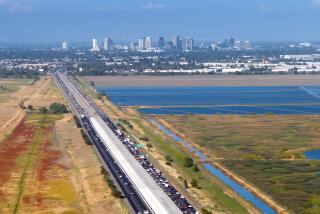Commentary : Why Car-Pool Lanes Should Be Opened to All Vehicles and Not Just a Select Few
If you’re traveling with a passenger between the hours of 6 a.m. and 9 a.m. or 3 p.m. and 6:30 p.m. on Interstate 15 between Kearny Mesa and Penasquitos, and you would like a leisurely 8-mile drive with few cars on “your” road, try the car-pool express lanes, any working day. For the remaining 18 or so hours a day, and weekends and holidays, this $31.4-million stretch of highway is deserted and useless.
The theory behind the car-pool lanes is splendid--get cars off the freeway by requiring two persons per vehicle for the privilege of using these exclusive and expensive lanes. Drivers wishing an easier daily commute will then gather up riders so as to use this special strip of roadway.
That’s the theory. But, in practice, it’s something else. It’s not that people are uncooperative and don’t want to car-pool. Most would if they could.
But, in San Diego’s far-flung boundaries, it’s not an easy thing to find two or more people who are employees of the same company (or one close by), who live in the same area, have the same work schedule, never work overtime or run late in the morning, and never vary their personal schedules to run errands, go to exercise class, stop at the grocery store, pick up the kids on the way home, drop off the kids on the way to work, go to the dentist, get sick, run late, leave early . . . well, you get the picture.
The California Department of Transportation has insisted that it is pleased with the use of the car-pool lanes and has urged us to “wait a year” before judging their success. Well, it has been almost a year, and use is still well below capacity. Caltrans’ most recent records show that an average of almost 7,400 vehicles traveled the lanes daily during August (2,953 southbound, 4,432 northbound.) This is up from an average of about 5,900 reported last October. But the expressway is capable of carrying 24,000 vehicles in a six-hour peak period--4,000 vehicles per hour--more than three times the actual use.
People must and will change travel behavior, insists Caltrans, and, to prove it, it plans to forge ahead with more express lanes, farther north on I-15 and Interstate 5. We need to ask what it is we are expecting to accomplish on this expensive stretch of road, when so many of San Diego’s highways are nearly gridlocked.
Are car-pool lanes really feasible or sensible, given San Diego’s geography and life style? Or are they a well-meaning but expensive luxury? Are they merely a test of enforced car-pooling, or is traffic management what we should really be talking about here before we commit more millions of our tax money to a decision that could well become another fiasco?
If the express lanes were open seven hours a day, 6 a.m.-9 a.m. and 3 p.m.-7 p.m., and could be used by all vehicles, it would effectively remove a far greater number of vehicles from the congested regular lanes. This would maximize use of the lanes, rather than settling for a fraction of its capacity and building more of the same. It would also move all traffic faster.
Even the existing use of the lanes has led to an increase of traffic speed in the regular lanes from 40 m.p.h. to nearly 50 m.p.h., according to Caltrans. Opening the lanes to the public would move all traffic more smoothly at speed-limit rates, making commuting to and from North County much less of a hassle.
North County is growing at an alarming rate, adding more and more traffic to compound the problem. The ultimate completion of the North County trolley extension will offer a partial solution, but this is still in the future. Now is when we need full utilization of all our roads.
No one wants a Los Angeles-style spaghetti tangle of crisscrossing roads, nor do we want their hours-long daily work commutes, which seems to be the way we’re headed.
There’s a salt-in-the-wound effect on frustrated drivers caught in the stop-and-slow traffic of I-15 who see beside them the forbidden lanes begging to be used--lanes bought and paid for out of their own tax money.
The aim of the expressway, and the promise, was to alleviate traffic congestion on I-15 between Kearny Mesa and Penasquitos. Opening the lanes to everyone would fulfill both the purpose and promise of this stretch of highway--the lanes would finally have maximum use, justifying the $31.4-million expense, and the goal of smoothing North San Diego’s workday commuting hassle would have been met.
More to Read
Sign up for Essential California
The most important California stories and recommendations in your inbox every morning.
You may occasionally receive promotional content from the Los Angeles Times.










